Gulian A.M., Zharkov G.F. Nonequilibrium Electrons and Phonons in Superconductors
Подождите немного. Документ загружается.


SECTION 10.2. OSCILLATORY PROPERTIES OF A TUNNEL SOURCE 261
the source obtained in Ref. 10 and figuring in a number of papers (see Ref.
11) does not possess this property. The relevant expression
10
arises if one
drops in Eq. (10.7) all but the terms in the corresponding round
parentheses, drops also the terms
Q
1,2
in (10.5) and (10.6), and then sets
Such a procedure may be justified only in the case of injection
in the range of directly above the gap, when the imbalance is insignifi-
cant. In the latter case, however, an interesting peculiarity of the tunnel
source resulting from the macroscopic phase coherence will be lost.
3. This peculiarity arises from the time-oscillating components
which are of a quantum nature (they vanish when
Since the solution of the nonlinear problem (10.13) yields the
which are explicitly time dependent, the entire
source (including the “stationary” generally “vibrates,” and the
Fourier spectrum of these oscillations (when the deviation from equilib-
rium is significant) cannot be represented by the first (Josephson) har-
monic only.
10.2.2. Oscillations of the Gauge-Invariant Potential
Thus if the electron injection in the NIS junction leads to the appearance of a
nonzero potential (see Sect. 8.1.1), in the SIS junction not only does the potential
appear, but having appeared, it should oscillate in time. At small these
oscillations would be of small amplitude near the stationary value and have the
Josephson frequency. We will now find certain quantitative characteristics of the
predicted effects.
Consider a symmetric SIS junction and use in calculations the collision integral
(4.119), accepting the electron–phonon collisions as the dominant relaxation
mechanism in (10.13). Assuming the deviation from equilibrium to be weak, we
present the difference in the form
Substituting (10.15) into (10.13) subject to (4.119) and (10.4), one obtains acoupled
system of integral equations for determination of
where the function is
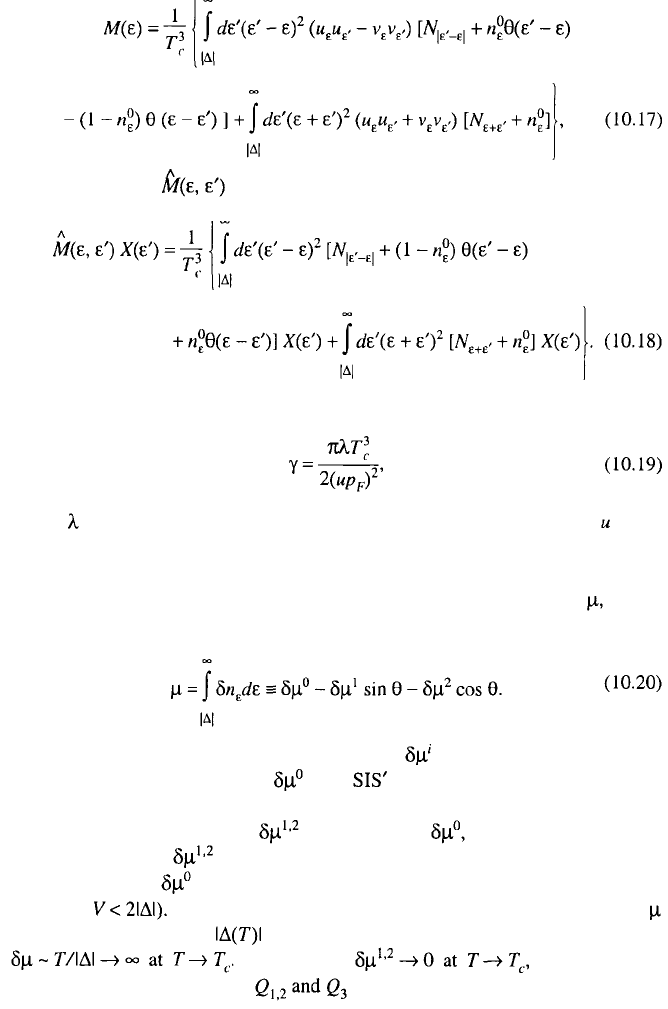
262 CHAPTER 10. JOSEPHSON JUNCTIONS
I
while the operator is defined as
We also denoted here
where is the dimensionless electron–phonon interaction constant and is the
sound velocity.
Obtaining results of the numerical solution of Eq. (10.16), shown in Fig. 10.1,
we may easily calculate the value of the gauge-invariant potential which
according to (8.6) equals
Figures 10.2 and 10.3 show the behavior of as the functions of V and T,
respectively. The stationary value of the junction, as an examination shows,
behaves analogously to that of the NIS junction. At sufficiently small values of v
(Fig. 10.2), the dependencies of are analogous to although with increasing
v the oscillations of reach a maximum and then diminish. At the same time,
the stationary part increases nearly without bounds (the only limitation is the
condition Another peculiarity of the oscillating terms in the potential
is their dependence on (i.e., on the temperature; Fig. 10.3). We have
Despite this, because of the
structural differences between [Eq. (10.4)].
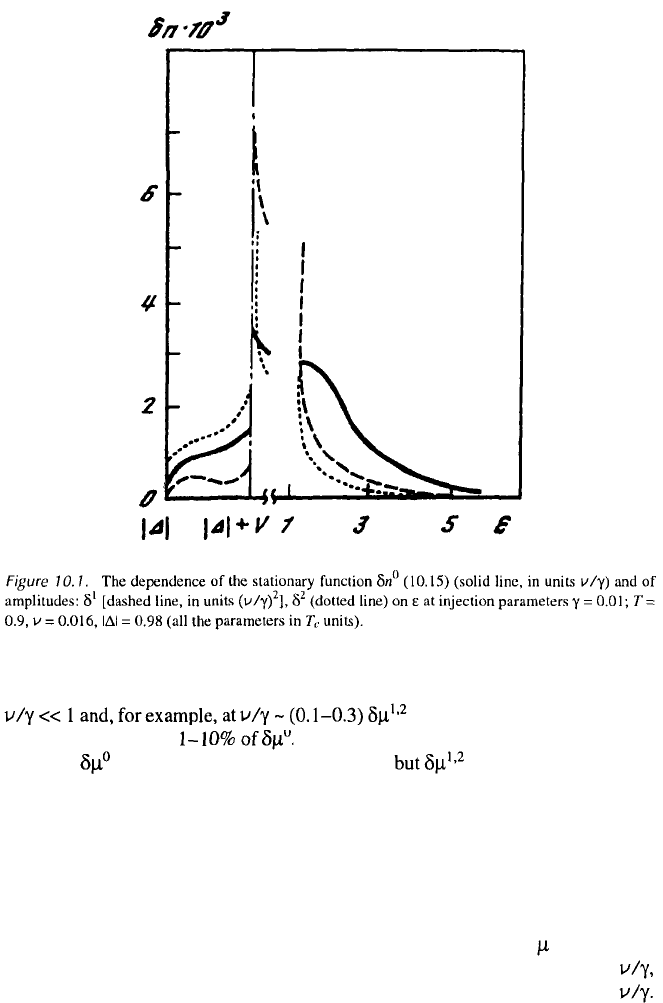
SECTION 10.2. OSCILLATORY PROPERTIES OF A TUNNEL SOURCE 263
We should note that this examination, strictly speaking, is valid only when
may, as is clear from Figs. 10.2
and 10.3, account for In the most favorable cases the characteristic
values of may be on the order of a microvolt, may be fractions of this
value (say, tens or hundreds of nanovolts for low-resistance aluminum junctions).
Thus the oscillations of the nonequilibrium gauge-invariant potential may be
identified experimentally a detection scheme should be like in Fig. 10.4 with
voltmeter replaced by an oscilloscope.
10.2.3. Satellites in Scattered Radiation
The amplitude of oscillations of the gauge-invariant potential examined in
the previous section is of the second order of smallness in the parameter
whereas the potential itself (its time-averaged value) is a first-order effect in
The question arises of whether the oscillations of the tunnel source can appear in
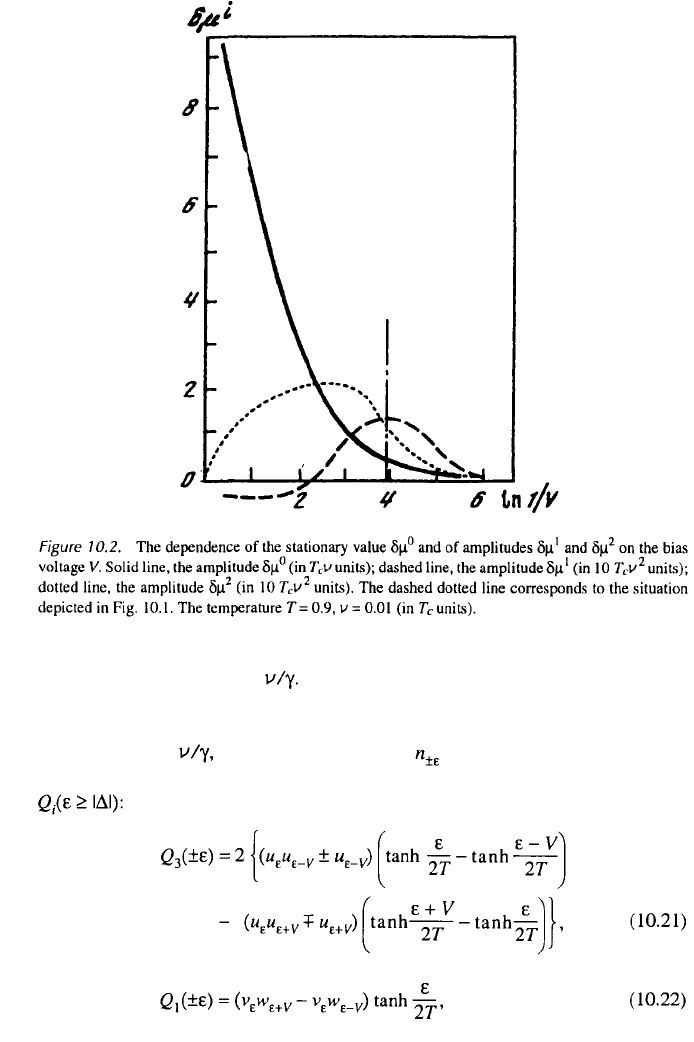
264
CHAPTER 10. JOSEPHSON JUNCTIONS
the first approximation in Such an effect is described in the following
paragraphs.
We will focus on the kinetic equation (10.13). In the first approximation over
a small parameter
the distribution functions
in (10.4) to (10.7) may be taken
as equilibrium ones. As a result, one obtains the following expressions for
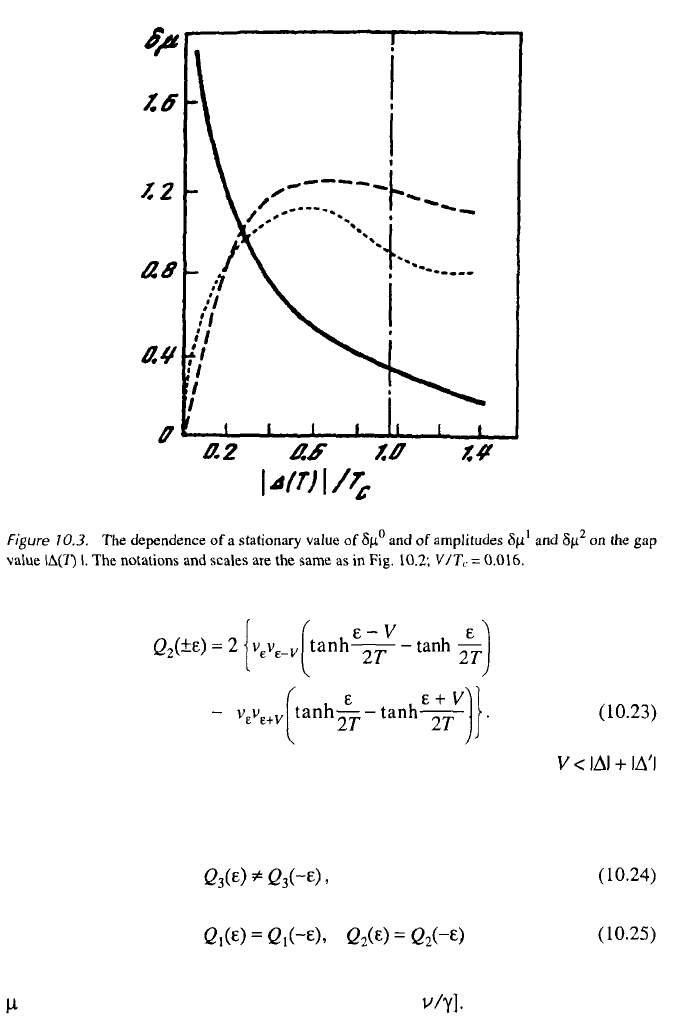
SECTION 10.2. OSCILLATORY PROPERTIES OF A TUNNEL SOURCE 265
In writing these expressions we have restricted ourselves to the case
(recall that the primed quantities and functions with shifted arguments correspond
to the injector). It is easily seen that the functions (10.21) to (10.23) have the
properties:
[The property (10.25) is responsible for the oscillating contribution to the potential
(10.20), being of the second order of smallness in From (10.25) it follows
that the oscillating nonequilibrium contributions to the distribution function of the
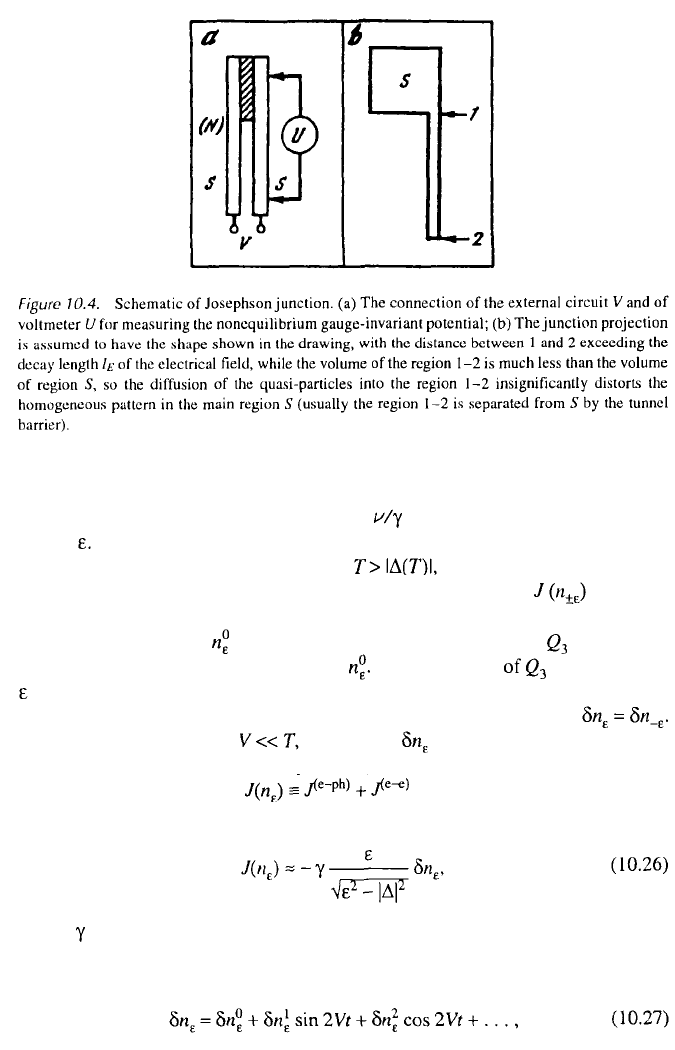
266
CHAPTER 10. JOSEPHSON JUNCTIONS
electron–hole excitations in the first order in are symmetric with respect to the
sign of We will find these contributions.
Consider the range of temperatures so that there is a sufficient
number of equilibrium electron excitations. The collision integral in (10.13)
may then be linearized in small deviations of the distribution function. The
stationary correction to in this case is determined by the term (10.21) and
yields an insignificant renormalization of The asymmetry with respect to
(property 10.24) causes an imbalance that we will also ignore in view of its
additional smallness (as follows from 10.21) and assume further that
Because the applied voltage
the variation
is localized at energies smaller
than T. This means that now we may use in (10.13) the relaxation time approxima-
tion for the collision integral (we postpone general discussion
of the validity of relaxation time approximation until Sect. 11.3):
where is a characteristic energy damping of the nonequilibrium excitations.
Substituting (10.21) to (10.23) and (10.26) into (10.13) and carrying out a Fourier
expansion of the nonequilibrium addition
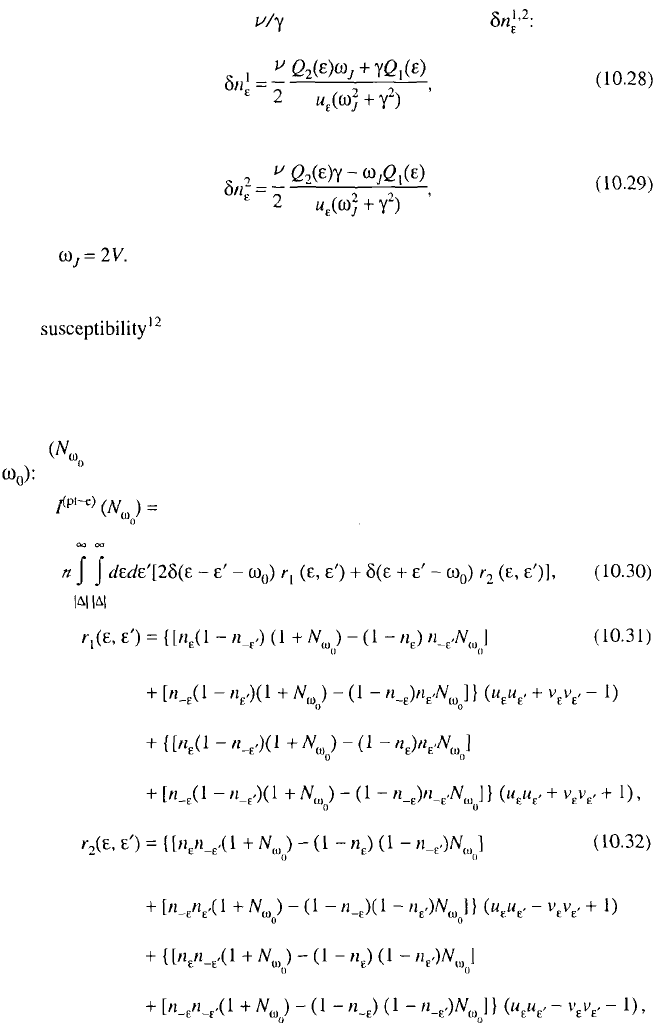
SECTION 10.2. OSCILLATORY PROPERTIES OF A TUNNEL SOURCE 267
one obtains in the first order in the following amplitudes
where Using these expressions we may now consider the scattering of
external electromagnetic radiation by a nonequilibrium tunnel junction.
For a proper description of the scattering process, we must know the general-
ized of the nonequilibrium junction in response to the action of the
electromagnetic radiation. For this purpose we will use the photon–electron colli-
sion operator. The electron–photon collision operator was derived in the quantum
treatment of electromagnetic radiation in Sect. 5.3. Within the same lines one can
show that the desired photon–electron operator for “dirty” superconductors has the
form corresponds to the occupation number of photons with the frequency

268
CHAPTER 10. JOSEPHSON JUNCTIONS
where the prefactor n is proportional to the fine structure constant:
We have written the operator (10.30) in a general form that also accounts for
the branch imbalance. We are interested now in the classical limit of (10.30) when
In this case one can carry from under the integral signs (henceforth
we assume that is included in the prefactor n; we will not need the explicit form
of this factor and it will be omitted in the following discussion). Retaining only the
terms that correspond to the action of a field with frequency one obtains
where the functions [determined subject to (10.27) to (10.29)] acquire the form
(the contribution of in 10.15 is negligible),
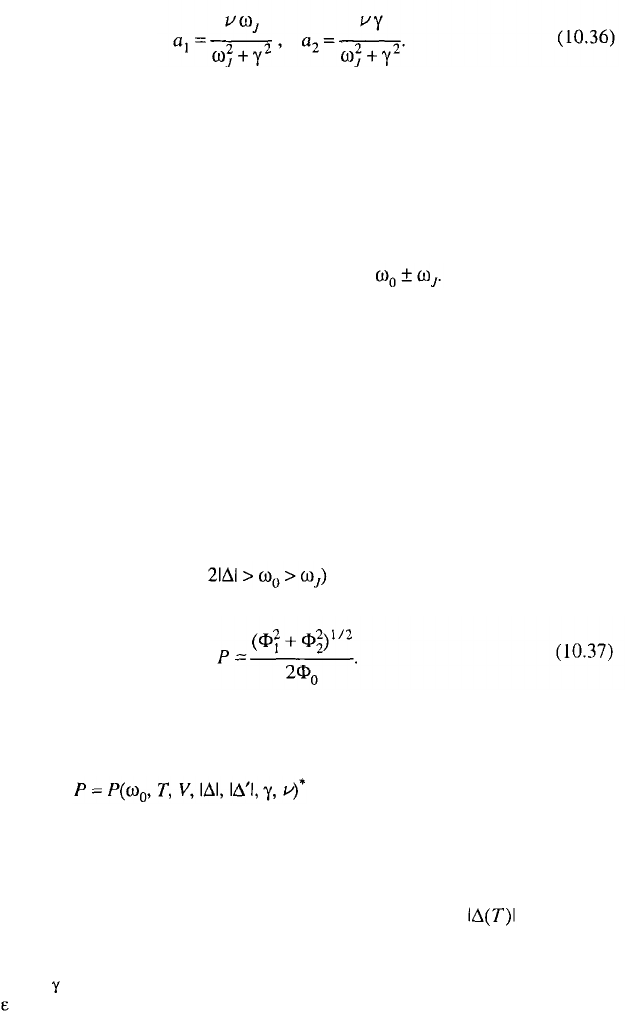
SECTION 10.2. OSCILLATORY PROPERTIES OF A TUNNEL SOURCE 269
Before providing the results of the numerical analysis of these integrals, we briefly
comment on the physical picture.
According to (10.27) to (10.29), the density of electron excitations in thin
superconducting film oscillates with a small amplitude near its steady-state value owing
to the existence of macroscopic phase coherence in a system of single-electron
excitations. The interaction between the external electromagnetic radiation and the
oscillating electron density of states causes the scattering of the electromagnetic
wave with the formation of satellites at frequencies
The collision operator (10.30) allows one to calculate the response of the
nonequilibrium system, for example, to find the relative intensities of the satellites
in the reflected radiation. From the point of view of spectroscopic experiments,
however, it is easier to deal with the absorption coefficient of the system (specifi-
cally, with the imaginary part of the dielectric constant) or, in other words, with
characteristics of the wave that passes through the film.
Consider a test wave passing through one of the films of an equilibrium
superconducting junction. The absorption coefficient (up to a constant factor) is
given by formula (10.34). We assume that the oscillations of the type mentioned
earlier occur in the film. Then the absorption coefficient would also oscillate in
accordance with (10.33). As a result, the amplitude of the transmitting wave would
be modulated (we assume that and the satellites would appear. The
estimate of their relative intensity is as follows:
The presence of a second film in the junction, in which oscillations also occur,
somewhat distorts this simple picture. We will return to this question later.
Consider now the results of the numerical analysis of the junction’s behavior.
The function was calculated for three metals: lead,
niobium, and tantalum with the parameters shown in Table 10.1 (the data for
aluminum will be used later, in further considerations).
The growth of P with a drop in temperature (Fig. 10.5) is due to the reduction
in the number of equilibrium excitations, which makes the film effectively more
transparent [for convenience Fig. 10.5 shows the dependence in the BCS
*The value of was introduced in calculations as a cutoff factor to remove divergence at the integration
over in (10.35).

270 CHAPTER 10. JOSEPHSON JUNCTIONS
model]. One may become sure of that by direct analysis of the behavior of the
amplitudes (see the dotted lines in Fig. 10.5).
The presence of a (logarithmic) maximum near (Fig. 10.6) is a charac-
teristic feature of the dependence of P on the voltage V across the junction.
Corresponding voltages are optimal for detection of satellites.
